Combining Laser-Induced Breakdown Spectroscopy and Visible Near-Infrared Spectroscopy for Predicting Soil Organic Carbon and Texture: A Danish National-Scale Study
Abstract
:1. Introduction
2. Materials and Methods
2.1. Soil Samples and Analysis
2.2. LIBS Measurement
2.3. Vis-NIRS Measurement
2.4. Data Analysis
2.4.1. Partial Least Square Regression
2.4.2. Variable Selection
2.4.3. Data Fusion
2.4.4. Correlation between LIBS and vis-NIRS Models
2.4.5. Regression Vector Analysis
3. Results and Discussion
3.1. Exploratory Data Analysis
3.2. Prediction Models
3.2.1. Single-Sensor Predictions
3.2.2. Combined LIBS-vis-NIRS Models
3.2.3. Correlation between LIBS and vis-NIRS Predictions
3.2.4. Regression Vector Analysis
LIBS
Vis-NIRS
3.2.5. Variable Selection
4. Conclusions
Author Contributions
Funding
Institutional Review Board Statement
Informed Consent Statement
Data Availability Statement
Acknowledgments
Conflicts of Interest
References
- Bünemann, E.K.; Bongiorno, G.; Bai, Z.; Creamer, R.E.; De Deyn, G.; de Goede, R.; Fleskens, L.; Geissen, V.; Kuyper, T.W.; Mäder, P.; et al. Soil quality—A critical review. Soil Biol. Biochem. 2018, 120, 105–125. [Google Scholar] [CrossRef]
- EC. Proposal for a Directive on Soil Monitoring and Resilience; European Commission: Brussels, Belgium, 2023. [Google Scholar]
- Cremers, D.A.; Ebinger, M.H.; Breshears, D.D.; Unkefer, P.J.; Kammerdiener, S.A.; Ferris, M.J.; Catlett, K.M.; Brown, J.R. Measuring total soil carbon with laser-induced breakdown spectroscopy (LIBS). J. Environ. Qual. 2001, 30, 2202–2206. [Google Scholar] [CrossRef] [PubMed]
- Idowu, O.J.; van Es, H.M.; Abawi, G.S.; Wolfe, D.W.; Ball, J.I.; Gugino, B.K.; Moebius, B.N.; Schindelbeck, R.R.; Bilgili, A.V. Farmer-oriented assessment of soil quality using field, laboratory, and VNIR spectroscopy methods. Plant Soil 2008, 307, 243–253. [Google Scholar] [CrossRef]
- Tavares, T.R.; Mouazen, A.M.; Nunes, L.C.; dos Santos, F.R.; Melquiades, F.L.; da Silva, T.R.; Krug, F.J.; Molin, J.P. Laser-Induced Breakdown Spectroscopy (LIBS) for tropical soil fertility analysis. Soil Tillage Res. 2022, 216, 105250. [Google Scholar] [CrossRef]
- Viscarra Rossel, R.A.; McGlynn, R.N.; McBratney, A.B. Determining the composition of mineral-organic mixes using UV–vis–NIR diffuse reflectance spectroscopy. Geoderma 2006, 137, 70–82. [Google Scholar] [CrossRef]
- Wangeci, A.; Adén, D.; Greve, M.H.; Knadel, M. Effect of sample pretreatment on pelletization and performance of laser-induced breakdown spectroscopy for predicting key soil properties. Spectrochim. Acta Part B At. Spectrosc. 2023, 206, 106712. [Google Scholar] [CrossRef]
- Villas-Boas, P.R.; Romano, R.A.; de Menezes Franco, M.A.; Ferreira, E.C.; Ferreira, E.J.; Crestana, S.; Milori, D.M.B.P. Laser-induced breakdown spectroscopy to determine soil texture: A fast analytical technique. Geoderma 2016, 263, 195–202. [Google Scholar] [CrossRef]
- Omer, M.; Idowu, O.J.; Brungard, C.W.; Ulery, A.L.; Adedokun, B.; McMillan, N. Visible Near-Infrared Reflectance and Laser-Induced Breakdown Spectroscopy for Estimating Soil Quality in Arid and Semiarid Agroecosystems. Soil Syst. 2020, 4, 42. [Google Scholar] [CrossRef]
- Ben-Dor, E. Quantitative remote sensing of soil properties. In Advances in Agronomy; Academic Press: Cambridge, MA, USA, 2002; Volume 75, pp. 173–243. [Google Scholar] [CrossRef]
- Hunt, G.R. Spectral signatures of particulate minerals in the visible and near infrared. Geophysics 1977, 42, 501–513. [Google Scholar] [CrossRef]
- Wetzel, D.L. Near-Infrared Reflectance Analysis. Anal. Chem. 1983, 55, 1165A–1176A. [Google Scholar] [CrossRef]
- Stenberg, B.; Rossel, R.A.V.; Mouazen, A.M.; Wetterlind, J. Visible and near infrared spectroscopy in soil science. Adv. Agron. 2010, 107, 163–215. [Google Scholar]
- Bricklemyer, R.S.; Brown, D.J.; Turk, P.J.; Clegg, S. Comparing vis–NIRS, LIBS, and Combined vis–NIRS-LIBS for Intact Soil Core Soil Carbon Measurement. Soil Sci. Soc. Am. J. 2018, 82, 1482–1496. [Google Scholar] [CrossRef]
- Chang, C.-W.; Laird, D.A. Near-infrared reflectance spectroscopic analysis of soil C and N. Soil Sci. 2002, 167, 110–116. [Google Scholar] [CrossRef]
- Knadel, M.; Gislum, R.; Hermansen, C.; Peng, Y.; Moldrup, P.; de Jonge, L.W.; Greve, M.H. Comparing predictive ability of laser-induced breakdown spectroscopy to visible near-infrared spectroscopy for soil property determination. Biosyst. Eng. 2017, 156, 157–172. [Google Scholar] [CrossRef]
- Milori DM, B.P.; Segnini, A.; Da Silva WT, L.; Posadas, A.; Mares, V.; Quiroz, R.; Neto, L.M. Emerging Techniques for Soil Carbon Measurements. In Climate Change Mitigation and Agriculture; Taylor & Francis: Oxford, UK, 2013; pp. 252–262. [Google Scholar] [CrossRef]
- Sanchez-Esteva, S.; Knadel, M.; Kucheryavskiy, S.; de Jonge, L.W.; Rubaek, G.H.; Hermansen, C.; Heckrath, G. Combining Laser-Induced Breakdown Spectroscopy (LIBS) and Visible Near-Infrared Spectroscopy (Vis-NIRS) for Soil Phosphorus Determination. Sensors 2020, 20, 5419. [Google Scholar] [CrossRef] [PubMed]
- Goueguel, C.L.; Soumare, A.; Nault, C.; Nault, J. Direct determination of soil texture using laser-induced breakdown spectroscopy and multivariate linear regressions. J. Anal. At. Spectrom. 2019, 34, 1588–1596. [Google Scholar] [CrossRef]
- Hermansen, C.; Knadel, M.; Moldrup, P.; Greve, M.H.; Karup, D.; de Jonge, L.W. Complete Soil Texture is Accurately Predicted by Visible Near-Infrared Spectroscopy. Soil Sci. Soc. Am. J. 2017, 81, 758–769. [Google Scholar] [CrossRef]
- Rosero-Vlasova, O.A.; Vlassova, L.; Pérez-Cabello, F.; Montorio, R.; Nadal-Romero, E. Soil organic matter and texture estimation from visible–near infrared–shortwave infrared spectra in areas of land cover changes using correlated component regression. Land Degrad. Dev. 2019, 30, 544–560. [Google Scholar] [CrossRef]
- Xu, L.; Hong, Y.; Wei, Y.; Guo, L.; Shi, T.; Liu, Y.; Jiang, Q.; Fei, T.; Liu, Y.; Mouazen, A.M.; et al. Estimation of Organic Carbon in Anthropogenic Soil by VIS-NIR Spectroscopy: Effect of Variable Selection. Remote Sens. 2020, 12, 3394. [Google Scholar] [CrossRef]
- Liu, B.; Guo, B.; Zhuo, R.; Dai, F. Estimation of soil organic carbon content by Vis-NIR spectroscopy combining feature selection algorithm and local regression method. Rev. Bras. Cienc. Solo 2023, 47, e0230067. [Google Scholar] [CrossRef]
- Greve, M.H.; Greve, M.B.; Bøcher, P.K.; Balstrøm, T.; Breuning-Madsen, H.; Krogh, L. Generating a Danish raster-based topsoil property map combining choropleth maps and point information. Geogr. Tidsskr.-Dan. J. Geogr. 2007, 107, 1–12. [Google Scholar] [CrossRef]
- Madsen, H.B.; Nørr, A.H.; Holst, K.A. The Danish Soil Classification. In Atlas of Denmark; The Royal Danish Geographical Society: Copenhagen, Denmark, 1992; Available online: https://rdgs.dk/publikationer/atlas-of-denmark-serie-1-bind-3_-danish-soil-classification.pdf (accessed on 10 October 2023).
- FAO. World Reference Base for Soil Resources. 1998. Available online: https://www.fao.org/3/w8594e/w8594e00.htm (accessed on 19 December 2023).
- Gee, G.W.; Or, D. 2.4 Particle-Size Analysis. In Methods of Soil Analysis; Soil Science Society of America: Madison, WI, USA, 2002; pp. 255–293. [Google Scholar] [CrossRef]
- Xu, X.; Du, C.; Ma, F.; Shen, Y.; Zhang, Y.; Zhou, J. Optimization of measuring procedure of farmland soils using laser-induced breakdown spectroscopy. Soil Sci. Soc. Am. J. 2020, 84, 1307–1326. [Google Scholar] [CrossRef]
- Wold, S.; Sjöström, M.; Eriksson, L. PLS-regression: A basic tool of chemometrics. Chemom. Intell. Lab. Syst. 2001, 58, 109–130. [Google Scholar] [CrossRef]
- Eilers, P.H. A perfect smoother. Anal. Chem. 2003, 75, 3631–3636. [Google Scholar] [CrossRef] [PubMed]
- He, Y.; Liu, X.; Lv, Y.; Liu, F.; Peng, J.; Shen, T.; Zhao, Y.; Tang, Y.; Luo, S. Quantitative Analysis of Nutrient Elements in Soil Using Single and Double-Pulse Laser-Induced Breakdown Spectroscopy. Sensors 2018, 18, 1526. [Google Scholar] [CrossRef]
- Nørgaard, L.; Saudland, A.; Wagner, J.; Nielsen, J.P.; Munck, L.; Engelsen, S.B. Interval Partial Least-Squares Regression (iPLS): A Comparative Chemometric Study with an Example from Near-Infrared Spectroscopy. Appl. Spectrosc. 2000, 54, 413–419. [Google Scholar] [CrossRef]
- Xu, X.; Du, C.; Ma, F.; Shen, Y.; Wu, K.; Liang, D.; Zhou, J. Detection of soil organic matter from laser-induced breakdown spectroscopy (LIBS) and mid-infrared spectroscopy (FTIR-ATR) coupled with multivariate techniques. Geoderma 2019, 355, 113905. [Google Scholar] [CrossRef]
- Brunet, D.; Barthès, B.G.; Chotte, J.-L.; Feller, C. Determination of carbon and nitrogen contents in Alfisols, Oxisols and Ultisols from Africa and Brazil using NIRS analysis: Effects of sample grinding and set heterogeneity. Geoderma 2007, 139, 106–117. [Google Scholar] [CrossRef]
- Tavares, T.R.; Molin, J.P.; Nunes, L.C.; Wei MC, F.; Krug, F.J.; de Carvalho HW, P.; Mouazen, A.M. Multi-Sensor Approach for Tropical Soil Fertility Analysis: Comparison of Individual and Combined Performance of VNIR, XRF, and LIBS Spectroscopies. Agronomy 2021, 11, 1028. [Google Scholar] [CrossRef]
- Wangeci, A.; Adén, D.; Nikolajsen, T.; Greve, M.H.; Knadel, M. Comparing laser-induced breakdown spectroscopy and visible near-infrared spectroscopy for predicting soil properties: A pan-European study. Geoderma 2024, 444, 116865. [Google Scholar] [CrossRef]
- Peng, Y. Vis-NIR and MIR Spectroscopy for Prediction and Mapping of Soil Organic Carbon and Clay. Ph.D. Thesis, Aarhus University, Aarhus, Denmark, 2014. [Google Scholar]
- Kramida, A.; Ralchenko, Y.; Reader, J.; Team, N.A. NIST Atomic Spectra Database, version 5.10; NIST: Gaithersburg, ML, USA, 2023. [Google Scholar] [CrossRef]
- Ben-Dor, E.; Inbar, Y.; Chen, Y. The reflectance spectra of organic matter in the visible near-infrared and short wave infrared region (400–2500 nm) during a controlled decomposition process. Remote Sens. Environ. 1997, 61, 1–15. [Google Scholar] [CrossRef]
- Katuwal, S.; Knadel, M.; Moldrup, P.; Norgaard, T.; Greve, M.H.; de Jonge, L.W. Visible-Near-Infrared Spectroscopy can predict Mass Transport of Dissolved Chemicals through Intact Soil. Sci. Rep. 2018, 8, 11188. [Google Scholar] [CrossRef] [PubMed]
- Viscarra Rossel, R.A.; Behrens, T. Using data mining to model and interpret soil diffuse reflectance spectra. Geoderma 2010, 158, 46–54. [Google Scholar] [CrossRef]
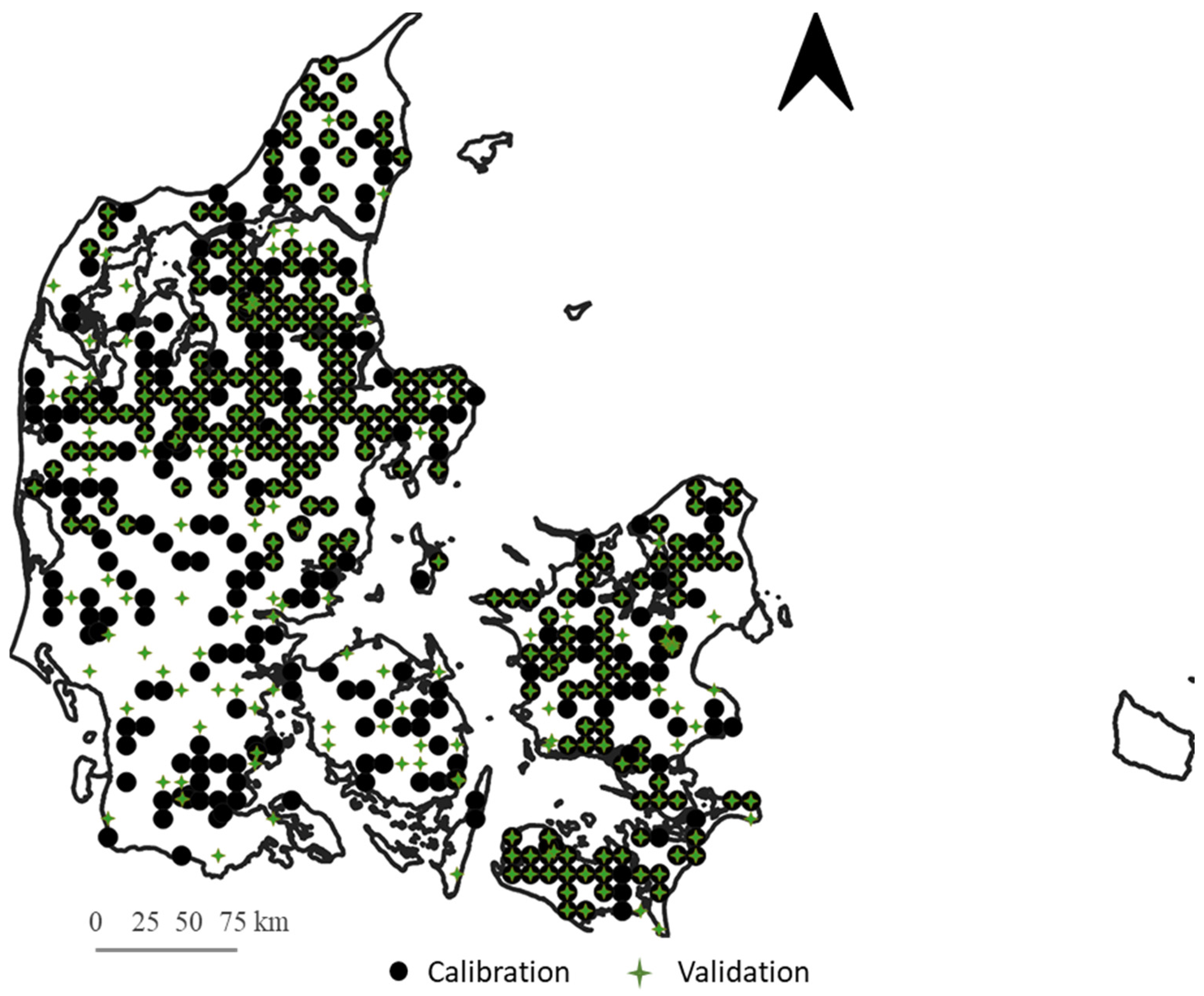
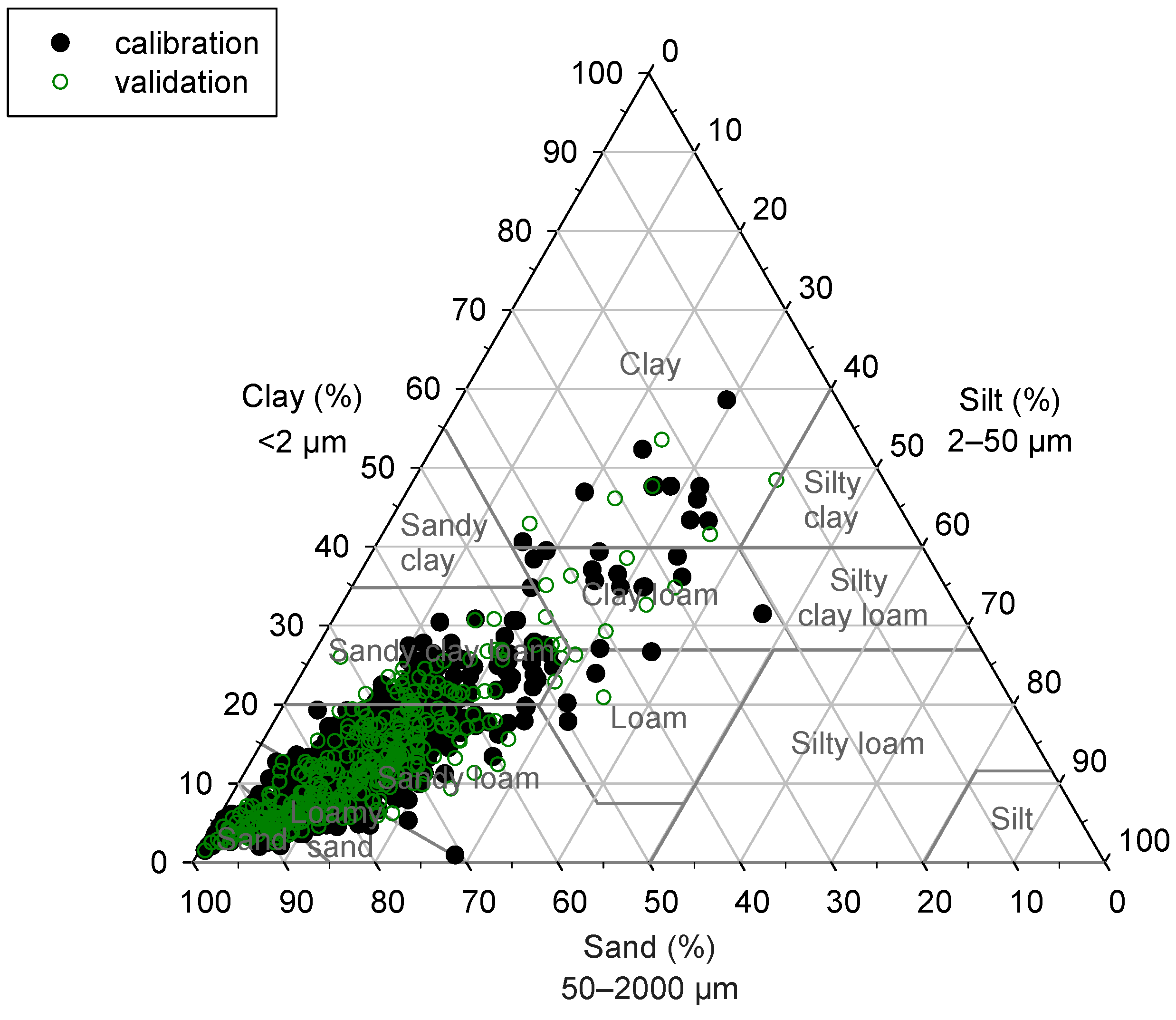



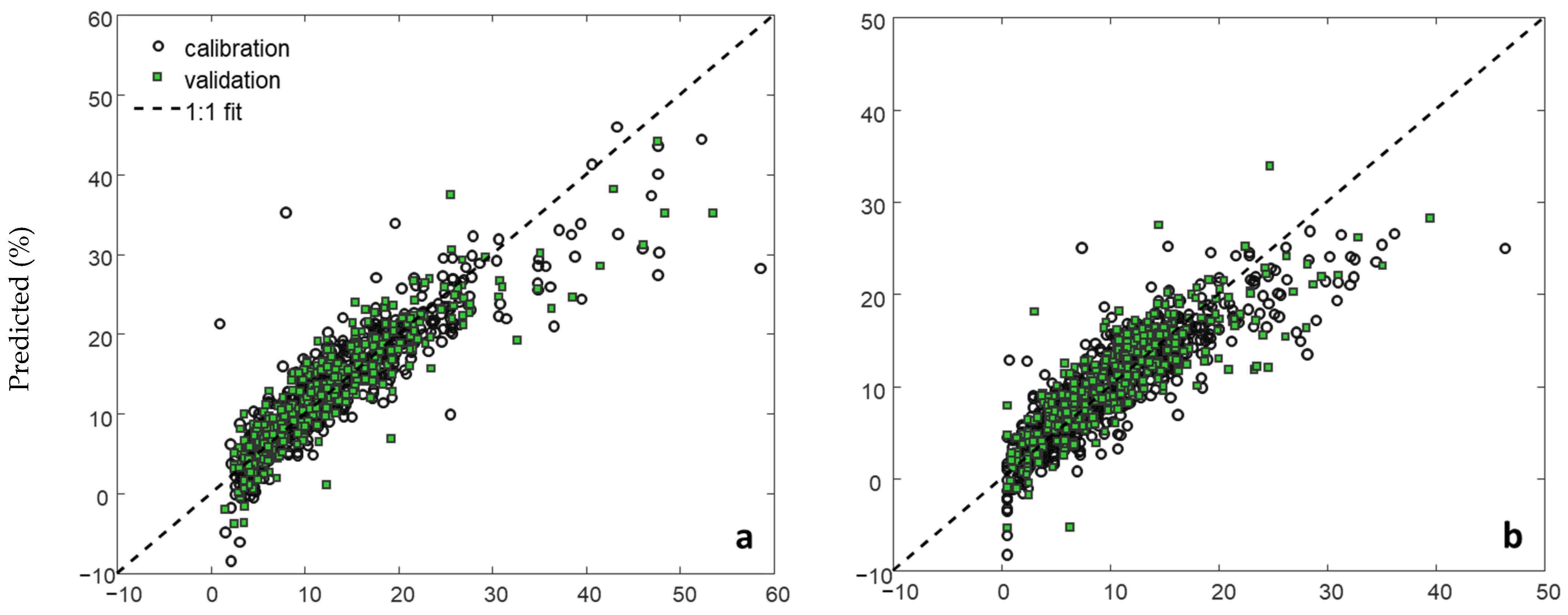


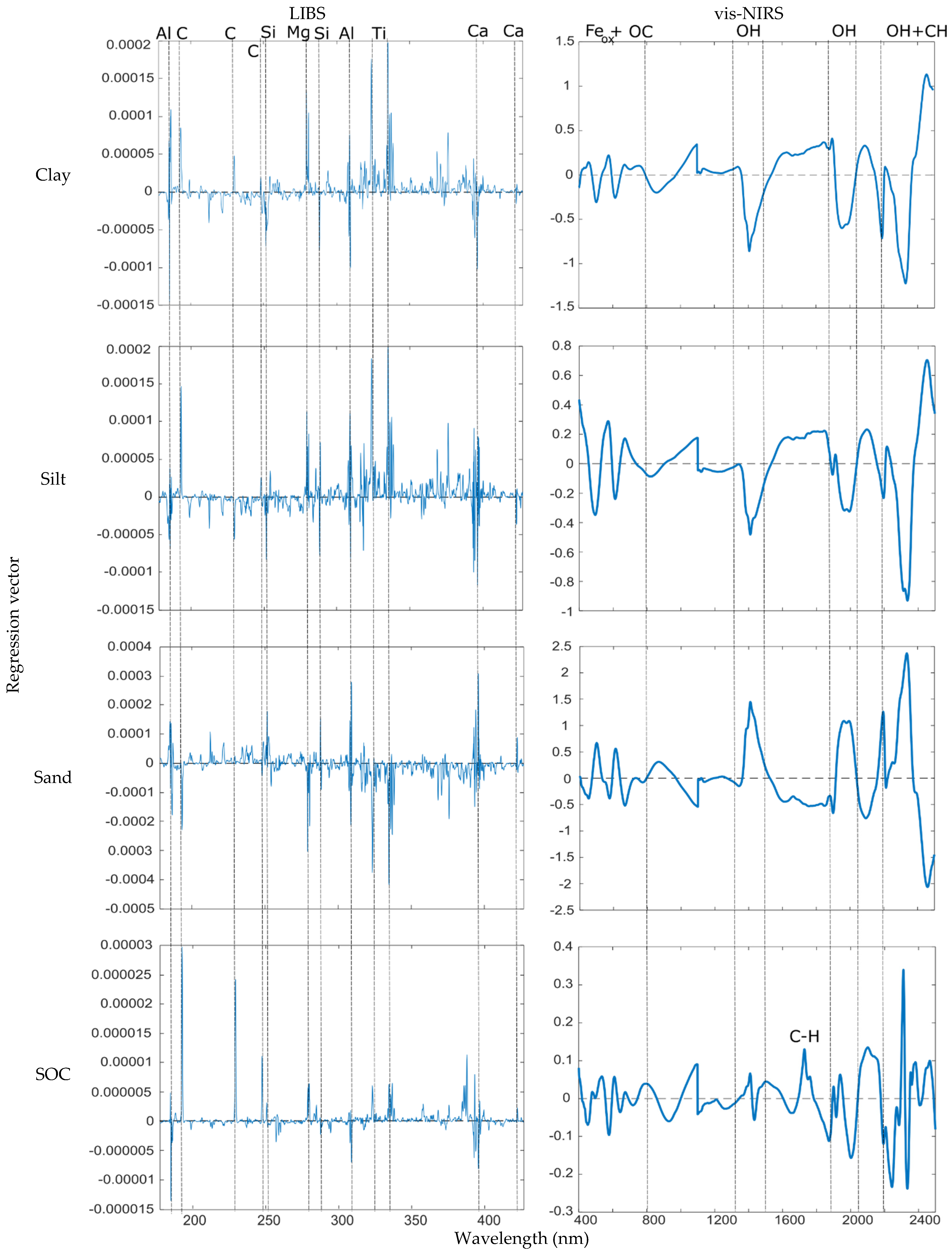
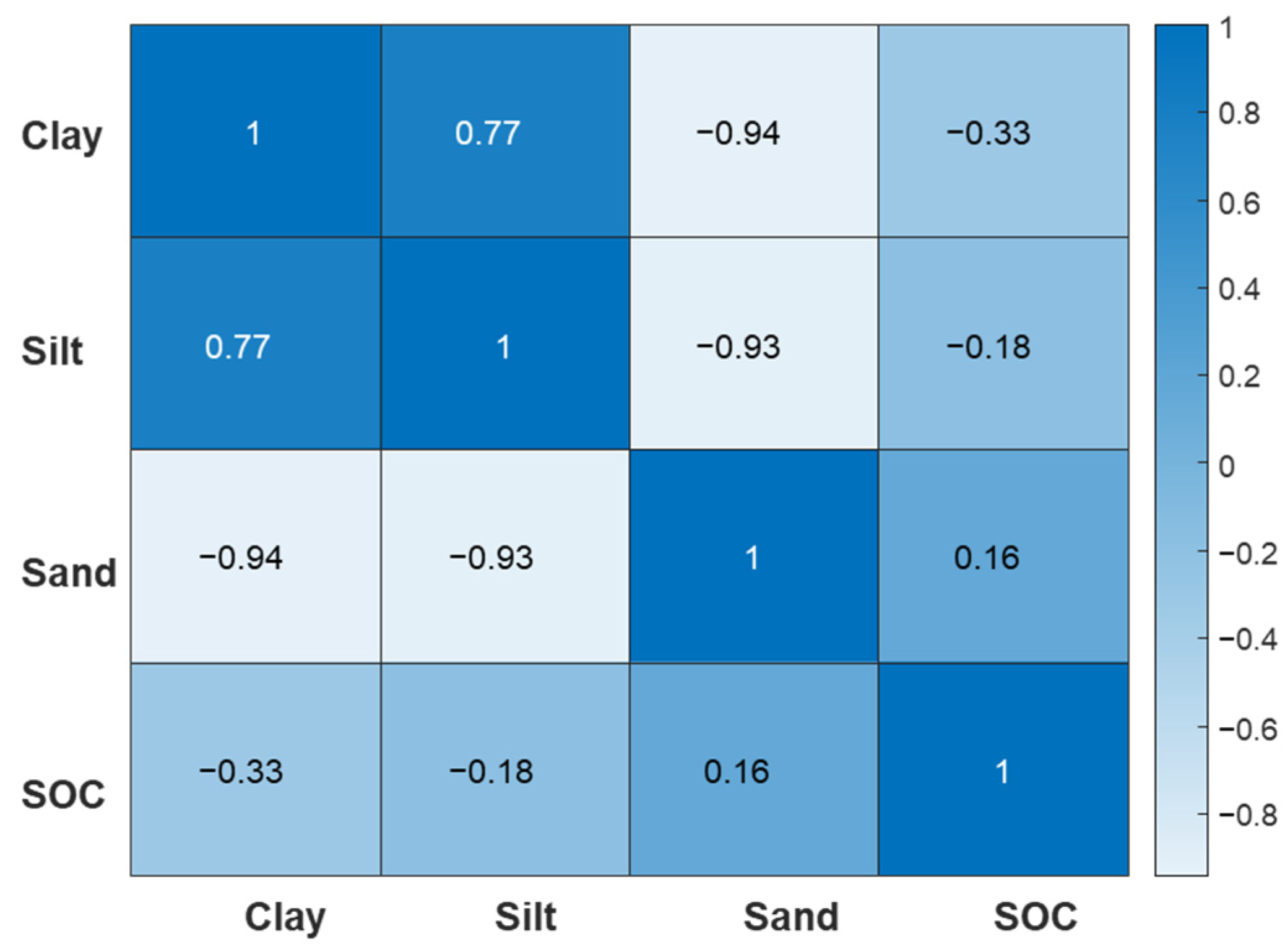
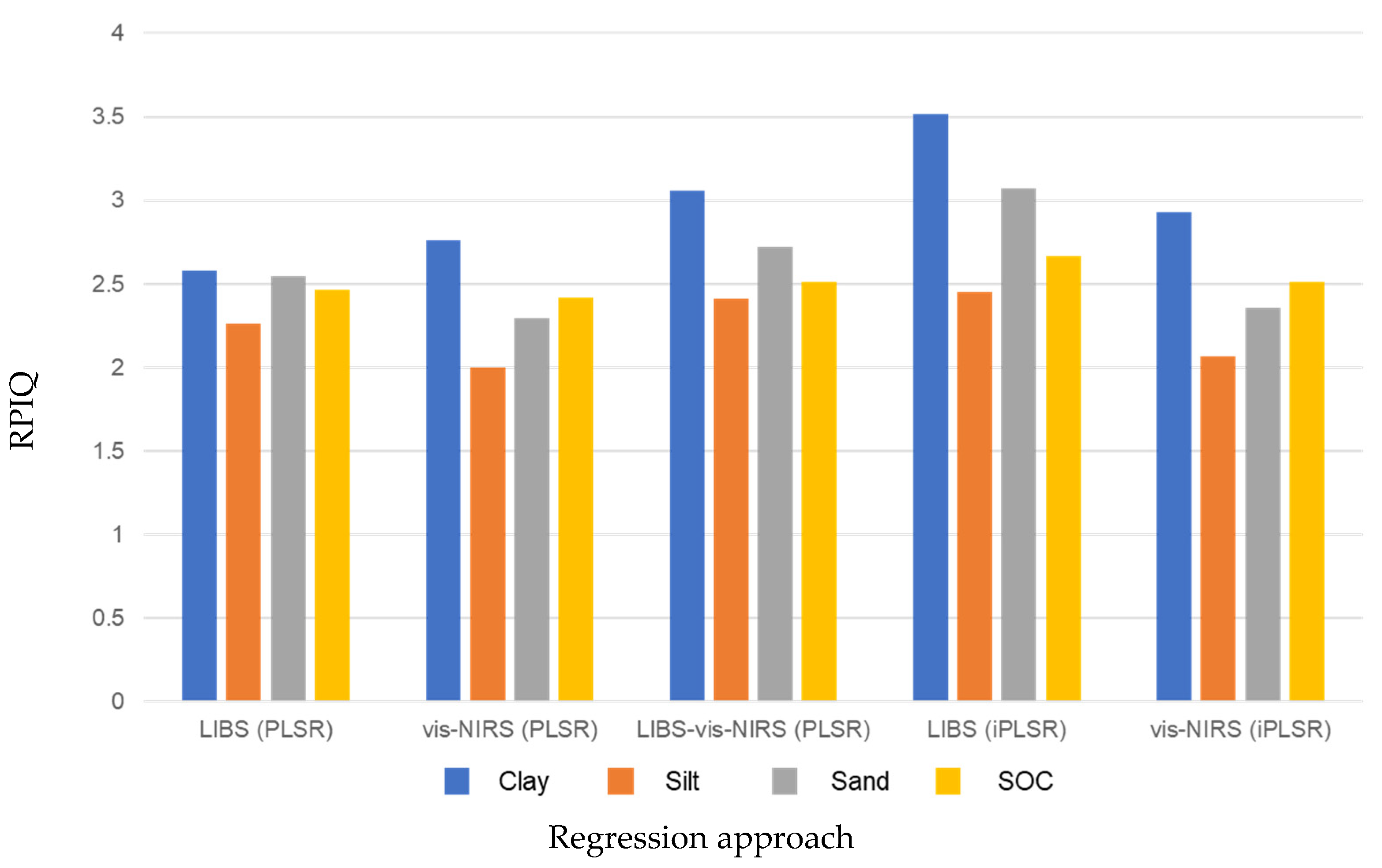
| Soil Property | Dataset | Average | Min | Max | SD c | CV d | Q1 e | Q3 f |
|---|---|---|---|---|---|---|---|---|
| Clay | Full (n = 1110) | 6 | 1 | 59 | 8.38 | 133 | 6 | 17 |
| Cal a (n = 739) | 6 | 1 | 59 | 8.41 | 133 | 6 | 17 | |
| Val b (n = 371) | 6 | 2 | 54 | 8.31 | 132 | 6 | 17 | |
| Silt | Full | 5 | 0 | 46 | 6.46 | 131 | 6 | 14 |
| Cal | 5 | 0 | 46 | 6.44 | 133 | 6 | 14 | |
| Val | 5 | 0 | 40 | 6.50 | 129 | 6 | 14 | |
| Sand | Full | 10 | 12 | 98 | 13.63 | 133 | 69 | 85 |
| Cal | 10 | 12 | 98 | 13.61 | 134 | 70 | 86 | |
| Val | 10 | 12 | 98 | 13.67 | 132 | 68 | 85 | |
| SOC | Full | 0.79 | 0.01 | 5.92 | 1.02 | 128 | 0.17 | 1.51 |
| Cal | 0.80 | 0.01 | 5.92 | 1.03 | 128 | 0.17 | 1.51 | |
| Val | 0.78 | 0.02 | 5.68 | 1.01 | 130 | 0.17 | 1.45 |
| Property | RMSECV a % | R2 cv b | RMSEP c (%) | R2 pred d | LV e | RPIQ f |
|---|---|---|---|---|---|---|
| LIBS | ||||||
| Clay | 5 | 0.71 | 4 | 0.74 | 7 | 2.6 |
| Silt | 4 | 0.67 | 4 | 0.67 | 10 | 2.3 |
| Sand | 7 | 0.73 | 7 | 0.75 | 10 | 2.5 |
| SOC | 0.53 | 0.73 | 0.52 | 0.73 | 7 | 2.5 |
| vis-NIRS | ||||||
| Clay | 4 | 0.74 | 4 | 0.77 | 10 | 2.8 |
| Silt | 4 | 0.56 | 4 | 0.58 | 7 | 2.0 |
| Sand | 8 | 0.67 | 8 | 0.69 | 10 | 2.3 |
| SOC | 0.49 | 0.77 | 0.53 | 0.73 | 13 | 2.4 |
| LIBS-vis-NIRS | ||||||
| Clay | 4 | 0.79 | 4 | 0.81 | 4 | 3.1 |
| Silt | 4 | 0.70 | 4 | 0.71 | 7 | 2.4 |
| Sand | 7 | 0.77 | 6 | 0.78 | 7 | 2.7 |
| SOC | 0.47 | 0.79 | 0.51 | 0.75 | 10 | 2.5 |
| Property | NV a | RMSECV b % | R2 cv c | RMSEP d % | R2 pred e | LV f | RPIQ g |
|---|---|---|---|---|---|---|---|
| LIBS | |||||||
| Clay | 200 | 4 | 0.81 | 3 | 0.86 | 14 | 3.5 |
| Silt | 210 | 3 | 0.73 | 3 | 0.72 | 13 | 2.4 |
| Sand | 80 | 6 | 0.81 | 6 | 0.83 | 13 | 3.1 |
| SOC | 50 | 0.53 | 0.74 | 0.48 | 0.77 | 12 | 2.7 |
| Vis-NIRS | |||||||
| Clay | 330 | 4 | 0.77 | 4 | 0.8 | 12 | 2.9 |
| Silt | 360 | 4 | 0.63 | 4 | 0.61 | 11 | 2.1 |
| Sand | 130 | 8 | 0.69 | 7 | 0.71 | 11 | 2.4 |
| SOC | 420 | 0.48 | 0.78 | 0.51 | 0.75 | 11 | 2.5 |
Disclaimer/Publisher’s Note: The statements, opinions and data contained in all publications are solely those of the individual author(s) and contributor(s) and not of MDPI and/or the editor(s). MDPI and/or the editor(s) disclaim responsibility for any injury to people or property resulting from any ideas, methods, instructions or products referred to in the content. |
© 2024 by the authors. Licensee MDPI, Basel, Switzerland. This article is an open access article distributed under the terms and conditions of the Creative Commons Attribution (CC BY) license (https://creativecommons.org/licenses/by/4.0/).
Share and Cite
Wangeci, A.; Adén, D.; Nikolajsen, T.; Greve, M.H.; Knadel, M. Combining Laser-Induced Breakdown Spectroscopy and Visible Near-Infrared Spectroscopy for Predicting Soil Organic Carbon and Texture: A Danish National-Scale Study. Sensors 2024, 24, 4464. https://doi.org/10.3390/s24144464
Wangeci A, Adén D, Nikolajsen T, Greve MH, Knadel M. Combining Laser-Induced Breakdown Spectroscopy and Visible Near-Infrared Spectroscopy for Predicting Soil Organic Carbon and Texture: A Danish National-Scale Study. Sensors. 2024; 24(14):4464. https://doi.org/10.3390/s24144464
Chicago/Turabian StyleWangeci, Alex, Daniel Adén, Thomas Nikolajsen, Mogens H. Greve, and Maria Knadel. 2024. "Combining Laser-Induced Breakdown Spectroscopy and Visible Near-Infrared Spectroscopy for Predicting Soil Organic Carbon and Texture: A Danish National-Scale Study" Sensors 24, no. 14: 4464. https://doi.org/10.3390/s24144464





